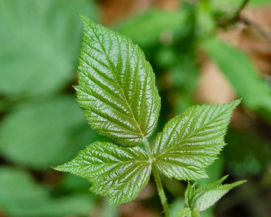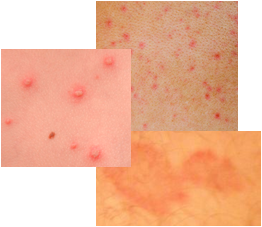Poison Ivy Rash on the Skin
Visit this
PICTURES OF RASHES PAGE
A poison ivy rash is one type of skin rash that can occur when contact is made with the poison ivy plant. Poison oak and poison sumac are two other commonly found outdoor plants that also cause an adverse skin reaction.
Poison Plant Identification
Sometimes it is difficult to distinguish between the various types of poisonous plants. Below are some brief descriptions to help you identify the plants and of course, stay away from contact with them.

Poison Ivy is identified by its three leaflets per stem.
Poison Oak is identified by its three leaflets per stem as well.
Poison Sumac is identified by a row of 6 to 10 leaflets per stem with one leaflet at the end of the stem and the remaining in two separate rows opposite to each other.
The skin rash is caused by a sap known as urushiol that is excreted from the plant. The sap causes an allergic skin reaction in many people, although not everyone reacts to the sap. Estimates are that up to 30 percent of people do not react to the sap from these poisonous plants.
Poison Ivy Rash Symptoms
The symptoms listed below usually begin to appear on the skin about 8 to 48 hours after contact with the sap from the poison ivy, poison oak, or poison sumac. The rash appears where direct contact with the sap occurred and therefore if the sap spreads around on the skin, then the poison ivy rash will spread to those locations as well. Actually, contact with the plant itself is not always necessary for the skin rash to appear. For example, if contact of the skin occurs with clothing, garden tools, or pets that have the sap on them, then the poison ivy skin rash can still occur. Here is a list of the symptoms that can occur when coming in contact with these poisonous plants:
- severe itch
- redness of the skin
- skin tenderness
- skin is warm in the affected areas
- the skin has an extreme burning sensation
- the skin swells or is inflammed in the affected areas
- presence of small pimples on the skin or much larger hives
- blisters are very common and often form on the surface of the skin
- blisters can break, ooze fluid, and crust over
- fluid from blisters is not contagious and does not spread the poison ivy skin rash
- streaky pattern to the rash which indicates a brushing contact with the plant
- more diffuse pattern if contact was with contaminated object or clothing
The poison ivy skin rash usually takes about ten days to clear, but can in some cases take up to three weeks. For individuals that have come in contact with a lot of sap, the poison ivy rash can be severe. The same is true for those that are severely allergic to the sap. Very large and widespread blisters on the skin may form. Also, the victim can experience swelling of the face, mouth, eyelids, etc. Medical attention should be pursued immediately when these allergic signs are present, especially if the victim is having trouble breathing.
